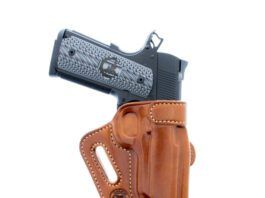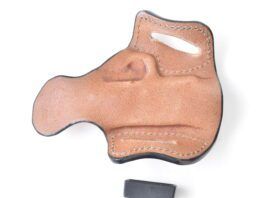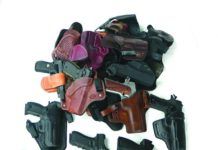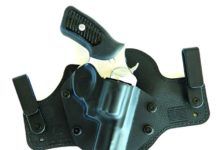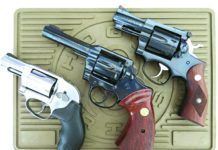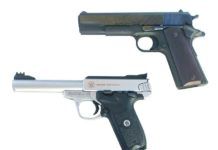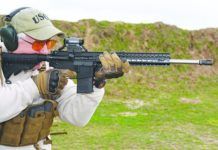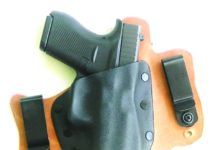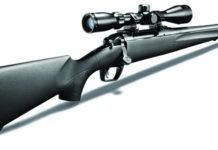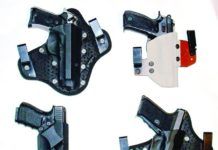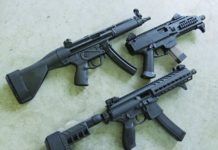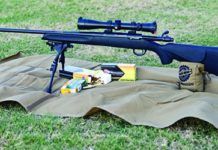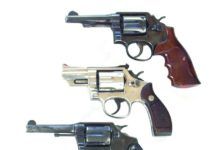We Test Inside-The-Waistband Holsters for $50 and More
Shooters know that quality leather gear is increasingly expensive. Like a good shoemaker, workmen capable of making quality holsters are few and far between. For many of us, this means buying off-the-shelf holsters. In this installment, we test more than a dozen holsters from makers large and small. While we tried to keep the price around $100 or less, in several cases we went over. This was a result of the raters adding options such as special reinforcements and sweat guards.
Testing Plastic and Kydex Holsters: The CYA Is a Bargain
The holster must have a balance of speed, security, and access. It cannot be buried under the clothing to the extent that it is difficult to access. A very fast draw isn't necessarily the main ingredient of a successful concealment rig. Good concealment that allows surprise is. Perhaps the adversary doesn't know you are armed, and he should not. There should be no indicators that show you are armed.
Let's look at reality. There is no draw faster than a standard belt holster carried on the point of the hip. This is also a holster that isn't compatible with concealed carry. The holster must be worn behind the hip under a covering garment at the least, and for better concealment, we move the holster inside the pants, or inside the waistband fashion as we call it. You must practice the draw to clear clothing, and is a real danger when clothing becomes tangled. The appendix carry requires less movement. Also, during the course of the day, you sometimes encounter people who like to bump into you or perhaps give a friendly pat. Some know you are armed; most should not. If they pat the groin area, they probably know you pretty well.
Revolver Holsters: Balancing Comfort, Speed, and Retention
Revolvers remain an important part of the personal defense scene. In some shops, the majority of handguns sold for personal defense are revolvers, usually small-frame 38s and compact 357 Magnum revolvers. The 357 Magnum remains a popular handgun among a large and loyal group, such as for outdoors carry and animal defense. Still other shooters deploy big-bore revolvers in 44 Special and 45 Colt chamberings. In all these cases, the shooter has to have a good holster to carry these handguns.
The design of a holster is important, and there are features specific to the revolver. A high ride keeps the revolver cylinder off the belt line. The revolver handle must be tilted into the draw, so the cant of the holster is important. The holster must retain a balance of speed and retention. The revolver cylinder presents a problem with concealment. The cylinder bulge inhibits the design of an inside-the-waistband holster, as an example. If the cylinder bulge rides below the belt line too much, the draw is affected. One of our senior raters noted that in the early days of police transition to the self-loader handgun, many of the holsters offered were simply revolver holsters without the cylinder bulge. The difference in balance and center of gravity wasn't understood or tended to.
In this evaluation, we considered that the modern revolver holster should be an individual design. Our focus is on concealed carry, with consideration given how revolvers might be used in the field. We tested a number of holsters from major makers and found them satisfactory to excellent in fit and function.
The fit of the holster should be sufficient that the revolver may be carried during normal day-to-day movement, even a brisk walk or run, with no danger of losing the handgun from the holster. The holster should allow a good sharp draw. After the revolver is drawn, the holster must not collapse, and the user should be able to re-holster the handgun without difficulty. Here's what we found.
Good Buys, or Goodbyes? We Test Experienced Wheelguns
Before law enforcement changed over to semi-automatic pistols, most officers carried a 357 Magnum revolver. Though some write off revolvers as the firearms equivalent of rotary phones, many of our staff consider the revolver to be a simple-to-operate self-defense firearm with built-in safeties and no magazine to lose. We also like the 357 Magnum cartridge. In addition to self-defense use, some team members have used the round to hunt medium-size game, so power isn't an issue.
Because a good revolver stands the test of time and usage well, but also depreciates enough to become affordable for more folks, we assembled three used revolvers from what was once the big three of U.S. revolver manufacturers—Colt, Smith & Wesson and Ruger. In general, we would rate the condition of these revolvers from 80 to 90 percent by NRA standards—we could tell they have been used, but we could not see where they had been abused. All samples were chambered in 357 Magnum, and all were designed for self-defense with barrel lengths that ranged from 2.15 inches to 4 inches and double-action/single-action trigger modes. Safeties are built into these three revolvers. The S&W uses a hammer stop, while the Ruger and Colt use hammer transfer bars.
From that starting point, this pack then diverged, with each offering characteristics that ranged from thumbs-down to thumbs-up for our shooters. Some incorporated an excellent grip that helped tame the felt recoil of the 357 Magnum; some were slim and more easily carried concealed, and some were equipped with large, easy-to-align sights.
With any used revolvers, we have a process of testing the chamber-barrel alignment with a range rod, and we found all were aligned. We also check the timing to see how the cylinder rotates in DA mode and SA mode to ensure the chamber is aligned with the bore of the barrel. They were. We also look at the gap between the front of the cylinder and the forcing cone or rear of the barrel. We use a feeler gauge and expect to have .006 clearance. Any less and there is a chance the cylinder may bind after shooting as fouling builds up. Any more and the user might experience splatter from burning gases escaping from the gap. We also look for forward and rearward play in the cylinder when locked in the frame. These revolvers were tight and stood as good examples of the revolver manufacturers' art and science.
We tested accuracy at 25 yards, which pushed the envelope of these revolvers' capabilities, depending on the user. We also found these revolvers had good accuracy. In close-range testing, some of these revolvers could get lead downrange fast and in good groups. Test ammunition consisted of Winchester PDX1 Defender 357 Magnum with a 125-grain bonded jacket hollowpoint, Aguila 357 Magnum with a 158-grain semi-jacketed hollowpoint, and SIG Sauer 38 Special +P, loaded with a 125-grain jacketed hollowpoint.
We had no issues with any of the revolvers. They all performed in DA and SA mode and loaded and ejected empties if we did our part and used gravity to our advantage. We did find that the S&W had the advantage as a concealed-carry revolver, but the Ruger and Colt were quite capable. Here's what we found out about these handguns after the brass cooled.
22-Caliber Handgun Shoot-Out: Smith, TacSol, Beretta, Colt
In this installment, we are looking at some of the best 22-caliber pistols for all-around target shooting and training for marksmanship and personal-defense practice, with an emphasis on viability for personal-defense training. Some handguns are just fine for general plinking, but the modern shooter demands the ability to train with combat lights or even a red-dot sight. All 22s do not allow this type of versatility. Let's look at four 22-caliber handguns and see how they stack up as modern trainers.
The 22 self-loading handgun is a great firearm that every handgunner should own at least one of. The 22 is a great trainer, and it is also a good small-game handgun, and it is even useful in some forms of competition. The absence of recoil and muzzle report compared to centerfire handguns is often touted, but recoil and muzzle blast are there, simply in easily manageable portions. The shooter is free to concentrate on trigger press, sight picture, sight alignment, and grip. Practice in offhand fire, combat practice, firing for extreme accuracy from a solid rest, clearing malfunctions and hunting game are just some of the practice that may be accomplished with the 22 pistol. For small-game hunting, excellent accuracy is demanded. For combat practice—and this is an important point—the handgun should be similar to the centerfire defense gun in accuracy. In that manner, the shooter isn't given a false sense of security by a 22 that is much more accurate than the 9mm or 45 they use for personal defense. When practicing with the 22, the serious shooter should use the same grip and trigger press that he or she uses when mastering the 9mm or 45. Using a lighter grip or shooting fast just because the 22 is so controllable doesn't cross over into personal defense skills; it is simply shooting for fun.
We collected two 22-caliber handguns and two 22-caliber conversion units for comparison. One of the handguns is a new model and the other, a relatively new and often overlooked pistol. The firearms tested included the Smith & Wesson Victory 22, Beretta Neos 22, Tactical Solutions' Glock conversion unit, and a Colt 22 Ace conversion unit.
AR-15 Carbines for Less Than $1300: The Winner is a Saint
A staff member recently paid $2300 for a complete AR-15 carbine without regret. But you may have noticed complete uppers selling for as little as $400 during the last rounds of holiday sales and complete carbines selling for less than $700. Why pay more? One answer would be to take advantage of the latest technology in terms of manufacturing, helpful features and improved ammunition. Forged rather than cast aluminum is now the standard, and machining is more exact thanks to computer numerically controlled (CNC) automation. The efficiency and versatility of barrels have been upgraded to take advantage of heavier bullets able to land a more effective blow at greater distance. Barrels with twist rates of 1:8 inches and even 1:7 inches have replaced the original-issue lands and grooves that spun the bullets at a rate of 1:9. Handguards are now modular platforms for lights, lasers, and sights, and ambidextrous fire controls are becoming more popular as well.
With the desire for a more up-to-date AR-15, we went shopping and found that we didn't have to break the bank — just get comfortable within a price range of about $900 to $1250 dollars. What we came up with was three AR-15s with upgrades that distinguished them from more traditional models.
Holsters for the Glock 42: We Test Ten for Everyday Carriers
The Glock 42 380 ACP is becoming a very successful handgun since its introduction three years ago, which has lead to many makers large and small rolling out holster rigs for this handgun. The Glock 42 is exceptionally well balanced but light, so it may require a little extra effort to be certain the Glock 42 is sheathed with a balance of speed and retention. Short and light guns sometimes roll out and require extra effort to holster securely. Fortunately, a number of makers offer good designs for this handgun, as we recently found out.
The Glock 42 is every bit a concealed carry handgun, and we think it is too important to go cheap on a holster for this activity, and you probably need more than one holster to cover all the different ways you or your spouse might carry it. Some of the holsters we tested below represent a good deal for the price and seem to do as well as others with more features. Here's what we thought about ten holsters that may suit your Glock 42 needs.
308 Winchester Bolt-Actions: Remingtons M783 Rifle Wins
Among the most useful, versatile, and powerful all-round sporting rifles is the 308 Winchester bolt action. These rifles are accurate, reliable, and can take on small to big game in many hunting conditions. When married with a good optic and in competent hands, they are well suited to take a 200-pound target at 200 yards and beyond, as a rule of thumb. The chambering is a joy to use and fire, compared to hard-kicking magnums, and offers plenty of recreational value. The bolt-action 308 is also a useful tactical rifle in many situations, and the round is widely used by law enforcement across the country.
We recently took a hard look at four bolt-action rifles chambered in 308 Winchester, with a special emphasis on looking for affordable options. So we chose two used rifles and one lower-cost new rifle and compared them to a rifle in a higher price range to ensure we weren't missing something that more dollars could provide. These rifles included the now-discontinued Mossberg ATR, the Remington 783, the Remington 700 SPS, and the Savage Axis. In this quartet, we shot three loads for accuracy testing and another load in offhand fire to gauge the accuracy of the rifles. As it turns out, the economy combination rifle that comes from the factory with a bore-sighted scope is a good deal. Though the Remington 783 was the most accurate rifle, we also liked the Remington 700 SPS a lot. Overall, however, the Savage Axis combination seems a best buy. Let's look hard at these rifles and delve into why we made these choices and to see if you agree with our assessments.
Comfortable Holsters: We Test Four to See How Well They Work
The inside-the-waistband holster is the most concealable of all holster types, but it is also the least comfortable. The IWB holster rides close to the body, so when the temperature soars, perspiration is thick, and our clothes cling to the body, a leather holster may become soaked with sweat and adhere to the body. Also, a stiff Kydex holster may become uncomfortable in the same conditions. Perhaps, then, a mix of modern material may be the best bet for making an effective defensive handgun wearable and bearable. To find out if they offer a better ride for our handguns, we took a look at four holsters from StealthGear and Comfort Holsters. We found much to like. We also discovered that such comfort is expensive compared to conventional holsters.
We will cover a lot of ground in this review. But since the holsters make the claim for greater comfort, that must be the focus point of this test. Still, we first evaluated each based on its merits as a holster, and our team found these four to be viable concepts in terms of retention and presentation.
So, compared to other holsters of the type, such as hybrids and Kydex, will these holsters exhibit a higher degree of comfort? Are there trade-offs? In this case, any trade-off is minimal. There is no trade-off, we felt, with the Onyx design. The padding does not make the holster more difficult to conceal. The Onyx is about 10 inches across its breadth compared to 7 inches with the Bentley. However, when both are laid on a table, the Bentley is taller. So, if you have a weak lumbar area and need to spread the weight of the handgun out on the back for increased comfort—exactly the scenario one of our raters faced—the Onyx gets the nod. If your belt space is limited and allocation of belt space is important, the Bentley would seem to make more sense. Both perform well, and the Bentley seems to offer more ease when reholstering. For pure comfort, the Onyx seems to be the better bet, particularly if you share the back problems one of our raters had. Since the Onyx costs $25 less than the Bentley, that is also a plus.
Forward-Mounted-Mag 9mm Pistols from SIG, Zenith, & CZ
In the October 2016 issue, we tested three high-capacity 9mm Luger pistols and found them somewhat lacking in defensive scenarios, though we did enjoy shooting one, the MPA Defender, which was sized more like a regular pistol than the carbine-like SIG MPX and which functioned better than an Uzi Mini Pro. But there are an increasing number of pistols that, save for a couple of features, function more like Short-Barreled Rifles (SBRs), which are controlled by much more stringent regulations under the National Firearms Act and are vastly more expensive and hard to get. The SIG MPX-PSB, for example, is similar to the unit we tested last October except it comes with a Stabilizing Brace, thus the "SB" in the name, compared to the "P" designation we initially tested.
This round, we found products more alike in size to the SIG Sauer MPX-PSB, namely, the CZ Scorpion EVO 3 S1 and the Zenith Firearms MKE Z-5RS with SB Brace. The Zenith and SIG came with a stabilizing brace, while the CZ did not, but it could be purchased separately. The SIG, CZ, and Zenith are tactical looking firearms because they all have a military ancestry that is especially noticeable due to the magazine mounted in front of the trigger guard and not in the grip. The three pistols tested are all semi-automatic, require two hands to shoot with any degree of accuracy, use high-round-capacity magazines compared to typical full-size handguns, and have the ability to be fired with a stabilizing brace. These pistols also represent three different operating mechanisms: the SIG uses a short push-rod gas system; the CZ a simple blowback system, and the Zenith a delayed roller-block mechanism. During firing, we noticed big differences in the mechanisms in both manual operation and cycling when fired, which we will get into. The ergonomics and controls differed as well, yet we found our ramp-up time transitioning between handguns to be short.
Initially, there is an awkwardness shooting these pistols because they feel like an SBR yet have no stock for a steady aim, and they are too heavy to fire in a Weaver, Isosceles, or hybrid stance with a two-hand hold like a typical handgun. We believe adequate range time and proper training is needed to master these pistols.
Most important, we wondered if, out of the box, these similar, yet different, pistols would work as home-defense choices. In our opinion, the upside of these three pistols is that they offer high magazine capacities, decent accuracy, and a lot of shooting fun. Yes, these pistols can make empty brass very quickly. On the downside is cost. Yes, you can purchase a lot less gun for a lot less money and achieve the same self-defense goal as what this trio delivers, we believe. Still, we looked forward to seeing what each firearm could do at the range.
Mid-Caliber Bolt-Action Rifles From T-C, Browning, and CZ USA
Recently, we assembled a panel and arrived at what could be described as a list of practical considerations for choosing an all-around rifle. Not a specialty piece, mind you, but a "daily driver," so to speak. Our test team came up with three considerations we wanted: power, accuracy, and portability. We agreed that in terms of power, we'd like to be able to hunt at least some deer-sized animals, but not with so much power that the rifle was too heavy to carry or generate so much recoil that it was unpleasant to shoot. To us, this meant short-action calibers greater than 223 Remington but less than 308 Winchester. In terms of accuracy, it wasn't long ago that producing a 1-inch group at 100 yards (1 minute of angle) was a high standard. Certainly 1 MOA is still a benchmark, but recent state-of-the-art machinery has made it possible to buy such guns over the counter. And last, but certainly not least, there's portability. Today, that is just as likely to mean aboard an ATV as it is over the shoulder. Either way, slender and compact is still the desired profile. Thus, the focus of this test became four bolt-fed short-action rifles in medium or midrange cartridges. The lineup was as follows:
We had intended to keep the maximum length of our rifles to less than 40 inches, but we decided to include the 41.5-inch-long Thompson Center Compass because we were eager to find out if this $399 rifle chambered for 22-250 Remington had recovered since its sudden recall for safety issues. Adding to its appeal was its threaded barrel, ready for a suppressor or muzzle brake.
Our shortest rifle was also chambered for 22-250. The $859 Browning X-Bolt Micro Midas offered a Grade 1 satin-finish walnut stock with 12.5-inch length of pull and about one additional inch of stock spacers. The Micro also weighed the least, as little as 6.1 pounds unloaded.
In the middle we chose the newest model 557 from CZ USA. The Sporter Short Action chambered for 243 Winchester was perhaps the most traditional rifle, with a checkered walnut stock.
The least traditional rifle, at least in terms of appearance, was the Howa Mini Action rifle from Legacy Sports International. Its multi-cam finish, 6.5 Grendel chambering, and 10-round detachable box magazine set it apart from the others. The right size overall, we hoped the big magazine sticking out the bottom would not make the Howa too difficult to pack.
Used 38 Sp. Revolver Contest: Colt, Smith & Wesson, Ruger
Revolvers make excellent home-defense handguns. They are simple to use and reliable and will come up shooting after long periods of storage. There are no springs compressed when the revolver is loaded, and no magazines to keep up with. The revolver may be chambered for powerful and efficient cartridges, such as the 38 Special +P and the 357 Magnum. For shooters able to engage in only minimal training, the revolver makes a lot of sense. Conversely, many very experienced shooters trust the revolver and little else. The smooth-rolling double-action trigger helps avoid flinch and the rhythm, once learned, allows excellent hit probability.
We set out to find four used revolvers for this Bargain Hunter segment. They had to be high quality and chambered for either the 38 Special or 357 Magnum cartridge, with the emphasis on 38 Special. While most homeowners will load these revolvers with 38 Special ammunition, the 357 Magnum is certainly a viable option, so we tested the revolvers chambered for the Magnum cartridge with these heavy loads as well. Because we were looking for bargains, we limited the used cost to a maximum of $500 counter price. We found one revolver at that maximum and three for considerably less, including two revolvers at $300. We chose medium-frame revolvers for two of the handguns and small frames for the other two handguns.
Three were six-shot revolvers and one was a five-shooter. We elected not to pursue heavy-frame revolvers, such as the Smith & Wesson L frame or Ruger GP100, and we also did not look for J-frame type snubnose revolvers. Basically, we were looking for affordable houseguns that would do a credible job of home defense if called upon. The contenders were as follows



























